Tom's Guide Verdict
With more than 20 hours of battery life, the ability to track almost any activity and a durable design, the Garmin fenix 5 is the outdoor GPS watch to get.
Pros
- +
Durable design
- +
Outdoor-readable display
- +
Long battery life
- +
Customizable display
Cons
- -
Expensive
- -
Low-resolution screen
Why you can trust Tom's Guide
Rugged Design
Befitting a watch meant for the outdoors, the Garmin fenix 5 has a rugged exterior that looks like it could take some abuse. Five screws hold a beveled, black bezel in place, while five circular buttons (three on the left, two on the right) ring the 1.2-inch display. There's an inner bezel around the screen, along with an outer bezel; together, they measure nearly half an inch, though that's mitigated visually by the design.
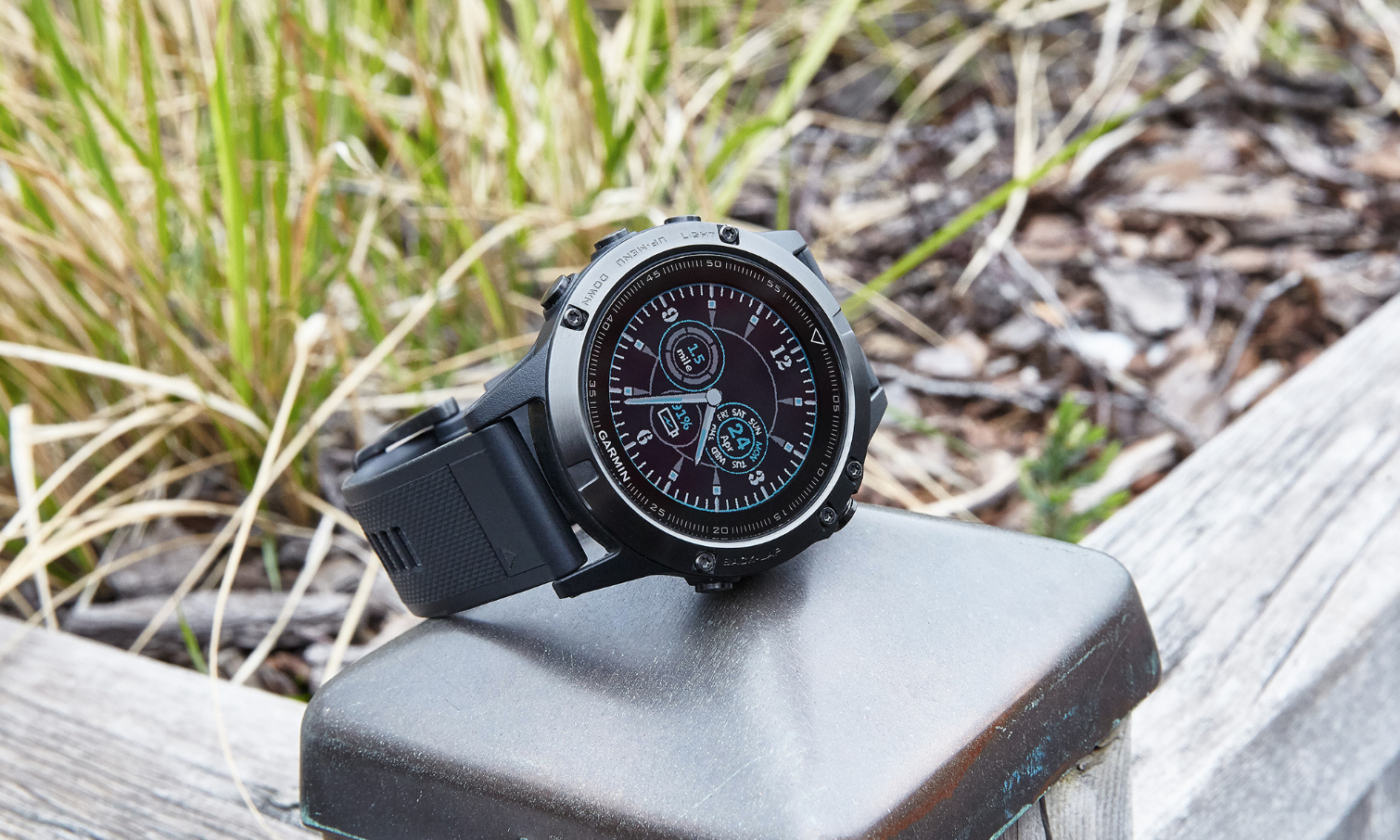
Garmin has eschewed touch screens in favor of a series of buttons on either side of the display. While not as newfangled as touchscreen-only smartphones, I like this the sensibility. When you have sweaty or gloved hands, It's a lot simpler to navigate an interface with buttons. Built tough, the fenix 5 is also water-resistant to 100 meters, compared to just 40 meters for the TomTom Adventurer.
The fenix 5 will even track you if you jump out of an airplane. This was a feature my mother would not let me test.
I prefer the fenix 5's design to that of the $349 TomTom Adventurer, another go-anywhere GPS watch, which has a square face with a small d-pad below it. While there's nothing wrong with how the TomTom looks, it feels a bit out of place if you're wearing it in a more formal setting.
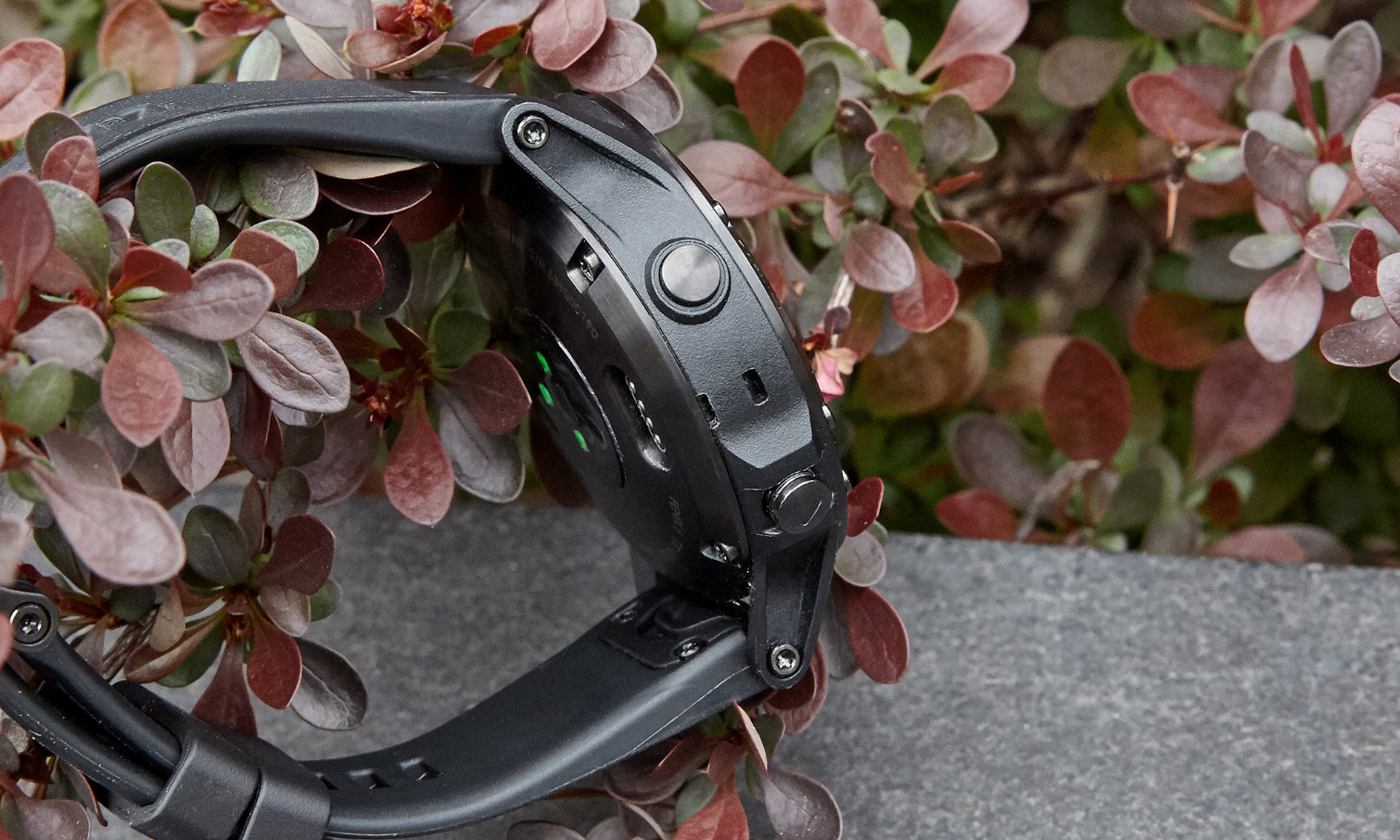
The fenix 5 is the midsize version of the three watches Garmin introduced. The smaller fenix 5S and the larger fenix 5X being the other two. While the fenix 5 has the same size display as the 5X (1.2 inches in diameter), the fenix 5's case is 1.9 inches in diameter and 0.6 inches thick. The fenix 5X is a tenth of an inch larger and thicker, and also half an ounce heavier, at 3.5 ounces.
It's tough to find an activity the fenix 5 can't track.
The smaller size and weight of the 5 made it much more comfortable for me to wear both on an everyday basis and when I was running. Typically, I use the Garmin Forerunner 235 on my runs, but I barely noticed the difference between it and the fenix 5 on my workouts.
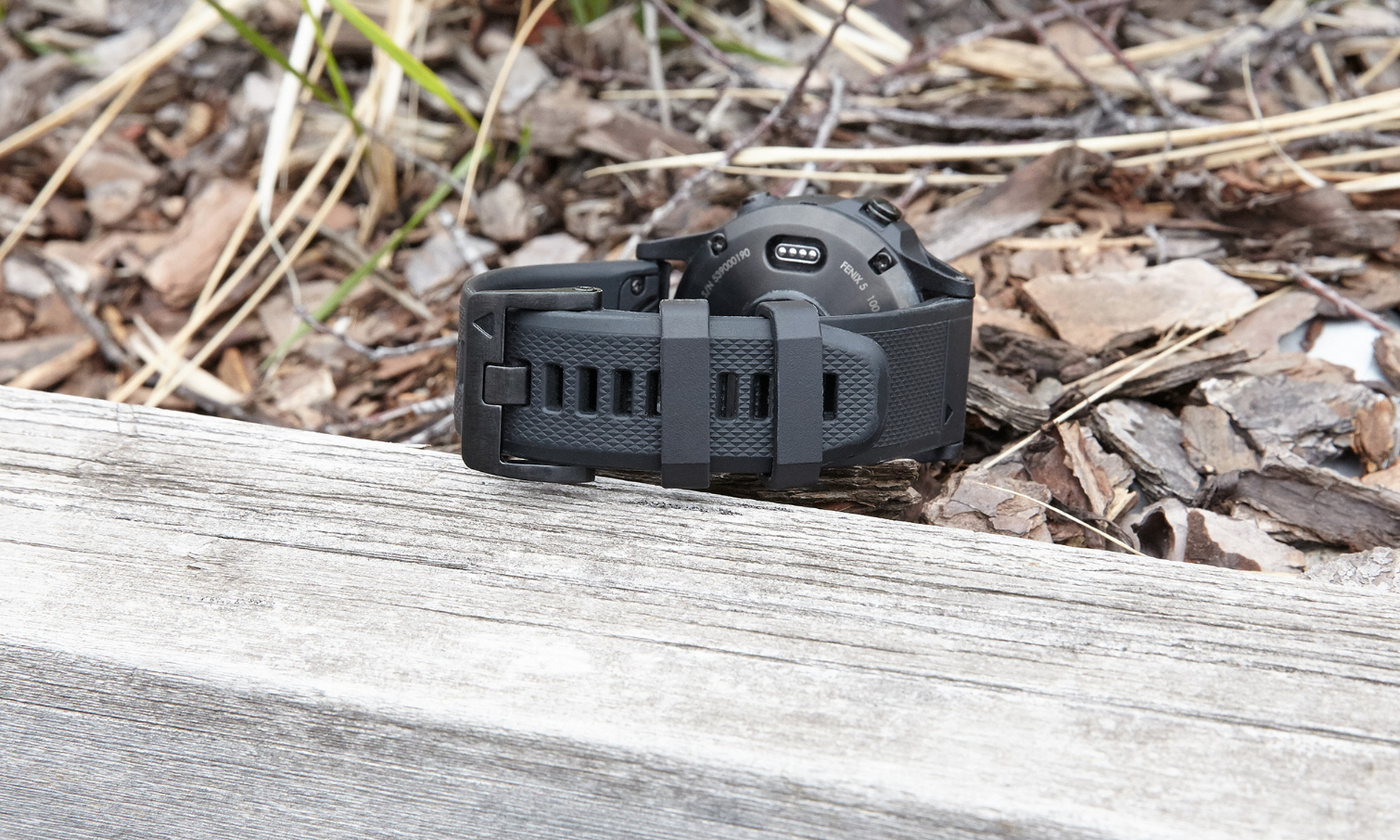
The fenix 5 I tested also had an elastomer band, which you can replace with a metal band that makes the watch look more suitable for a night on the town. You wouldn't want to go running with the latter, though. The bands can be switched relatively quickly, too.
Display
The fenix 5 has an always-on color display (a plus) with a transflective surface that uses sunlight to make the screen brighter. I never had a problem reading the display, even in direct sunlight. However, when you're indoors, the screen, while still viewable, is much dimmer than you'll see on most smartwatches. It does have a backlight, though.
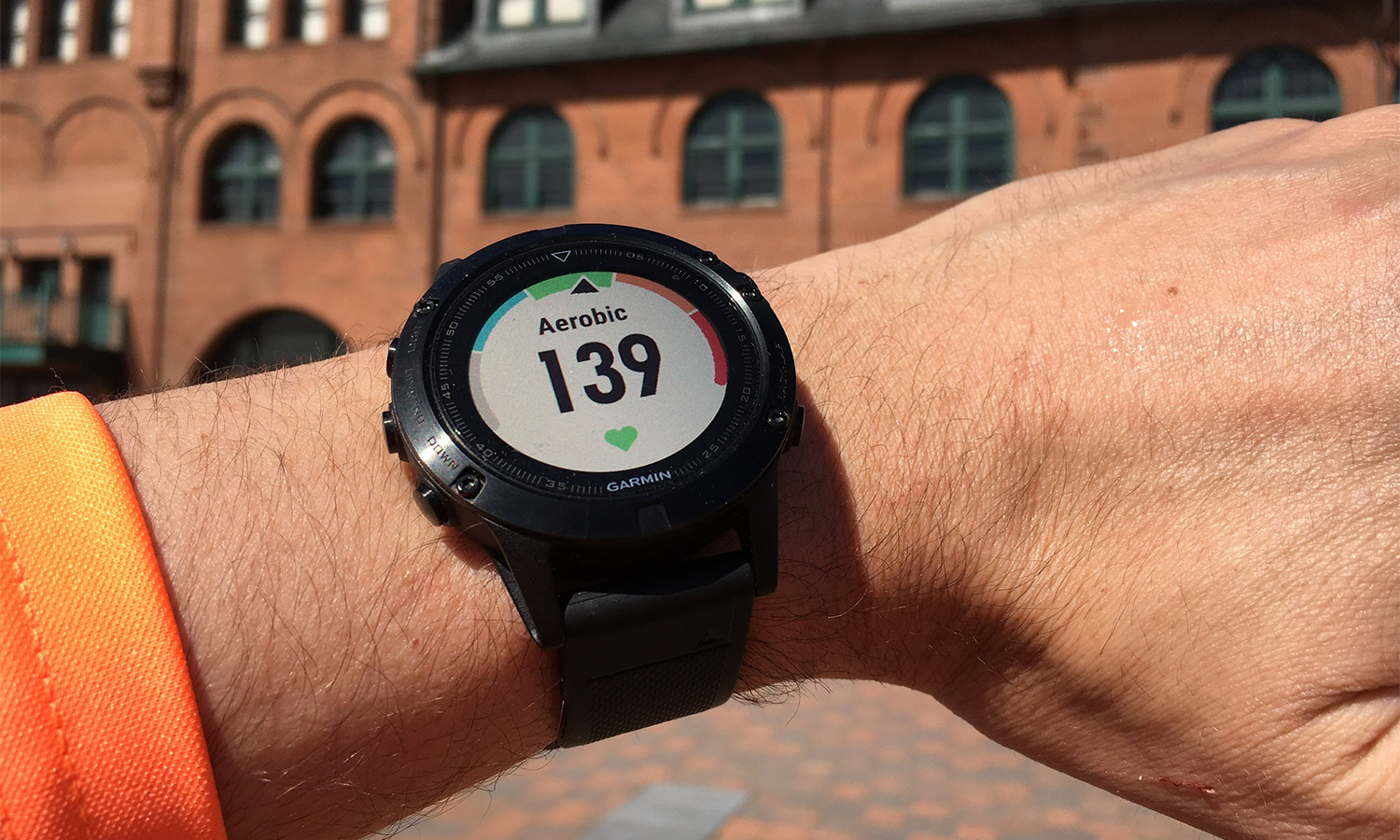
The fenix 5's resolution of 218 x 218 pixels is also much lower than that of smartwatches, such as the Samsung Gear S3 frontier (360 x 360), so things aren't nearly as crisp, but this is not a dealbreaker.
Tracked Activities
It's tough to find an activity the fenix 5 can't track; in addition to monitoring running, the watch can record your metrics when you're hiking, climbing, mountain biking, golfing, skiing (downhill and cross-country), snowboarding, stand-up paddleboarding, swimming and rowing. The fenix 5 will even track you if you jump out of an airplane. This was a feature my mother would not let me test.
A breadcrumb feature makes it easy to find your way back where you started if you're in unfamiliar territory.
I tested the watch on two of my favorite outdoor activities: running and skiing.
Running Performance
I used the fenix 5 while I was training for a half marathon, as well as during the race itself.
The fenix 5's optical heart rate monitor proved accurate, but it did not respond to changes as quickly as a chest strap would.
The watch, which uses GPS as well as GLONASS, measured the race distance — a 13.1-mile USATF (USA Track and Field)-certified course — as 13.16 miles, which is exceptionally accurate.
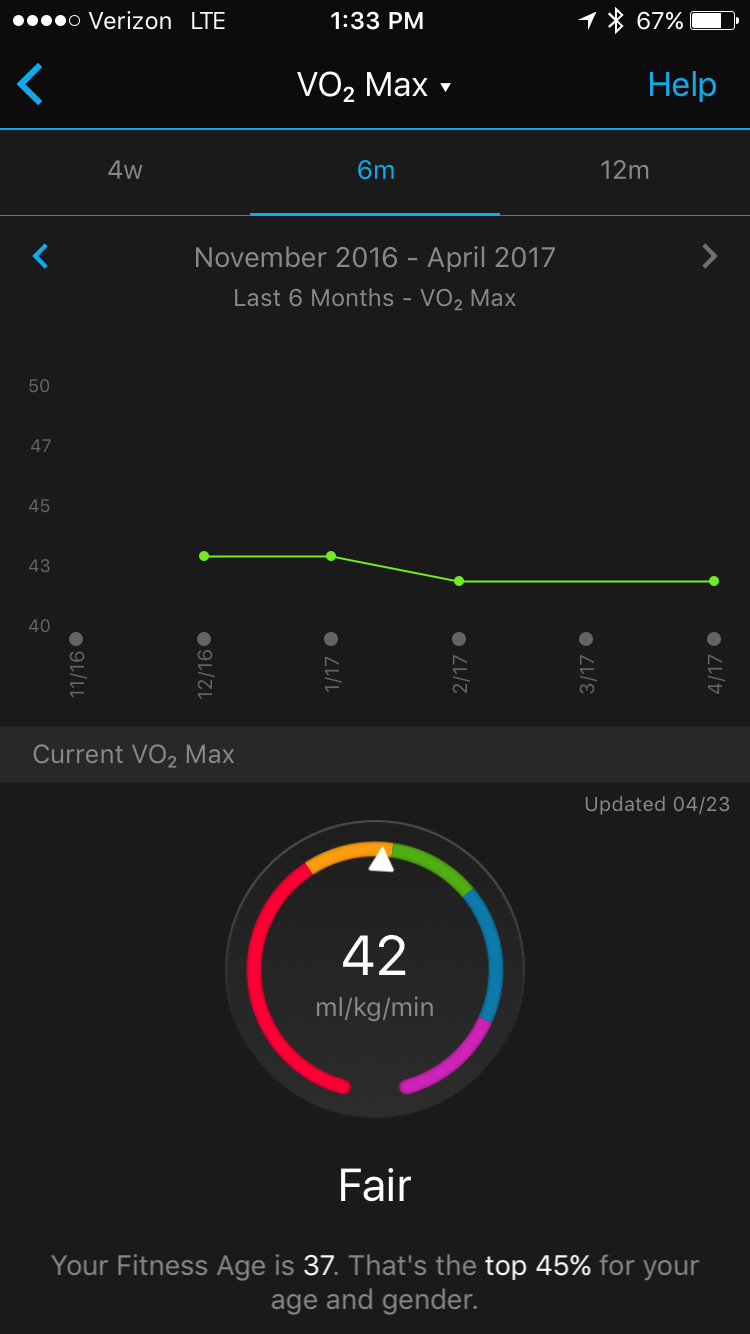
The fenix 5 also gives you a VO2 max score (a measure of your overall fitness level), the intensity of your training over the past week and a race predictor, which lists how fast the watch thinks you'll complete a 5K, 10K, half marathon and full marathon.
For each run that you do, you get a training effect, which gives you a score for both aerobic and anaerobic activity. After running a half marathon, I received a score of 5 (the highest you can get) for aerobic and 3.7 for anaerobic activity. The fenix 5 also said I was overreaching, which, in some respects, you want to do in a race.
A Training Status screen shows how productive your exercises have been and gives you a general sense if your fitness level is improving, holding steady or decreasing. After a week of not running, I received an ominous "detraining" message.
After a run, I could cycle through screens on the watch, which showed me splits, an elevation plot, a map of where I ran, how much time I spent in each heart rate zone and other details. I was impressed with the wealth of information right on my wrist.
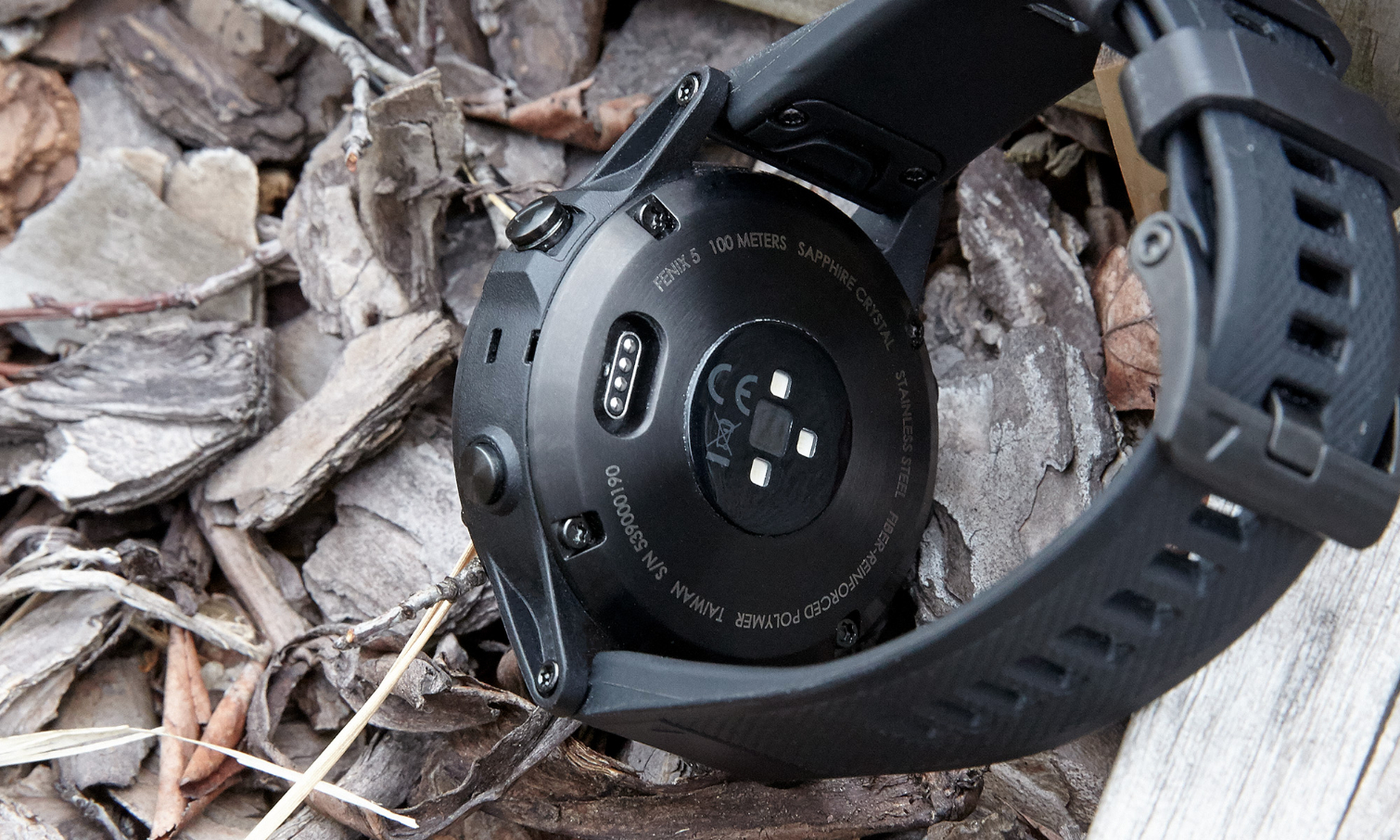
The fenix 5's optical heart rate monitor proved accurate, but it did not respond to changes as quickly as a chest strap would. I went on a run wearing both the fenix 5 and a Polar H7 chest strap connected to MapMyRun. The Polar strap recorded my average heart rate as 158 beats per minute and my max as 175 bpm. By comparison, the fenix 5 said my average HR was 159 bpm and the max was 177. However, Garmin's watch took a few more seconds than the Polar strap to record changes in my heart rate, which is typical for an optical monitor.
Skiing Performance
I also took the fenix 5 for a long weekend skiing in Banff, Canada, where the watch dutifully tracked my runs around Lake Louise and Sunshine Village. Even high up in the Canadian Rockies, the fenix 5 was quick to acquire a GPS signal, and smart enough to know when one run ended and another began.
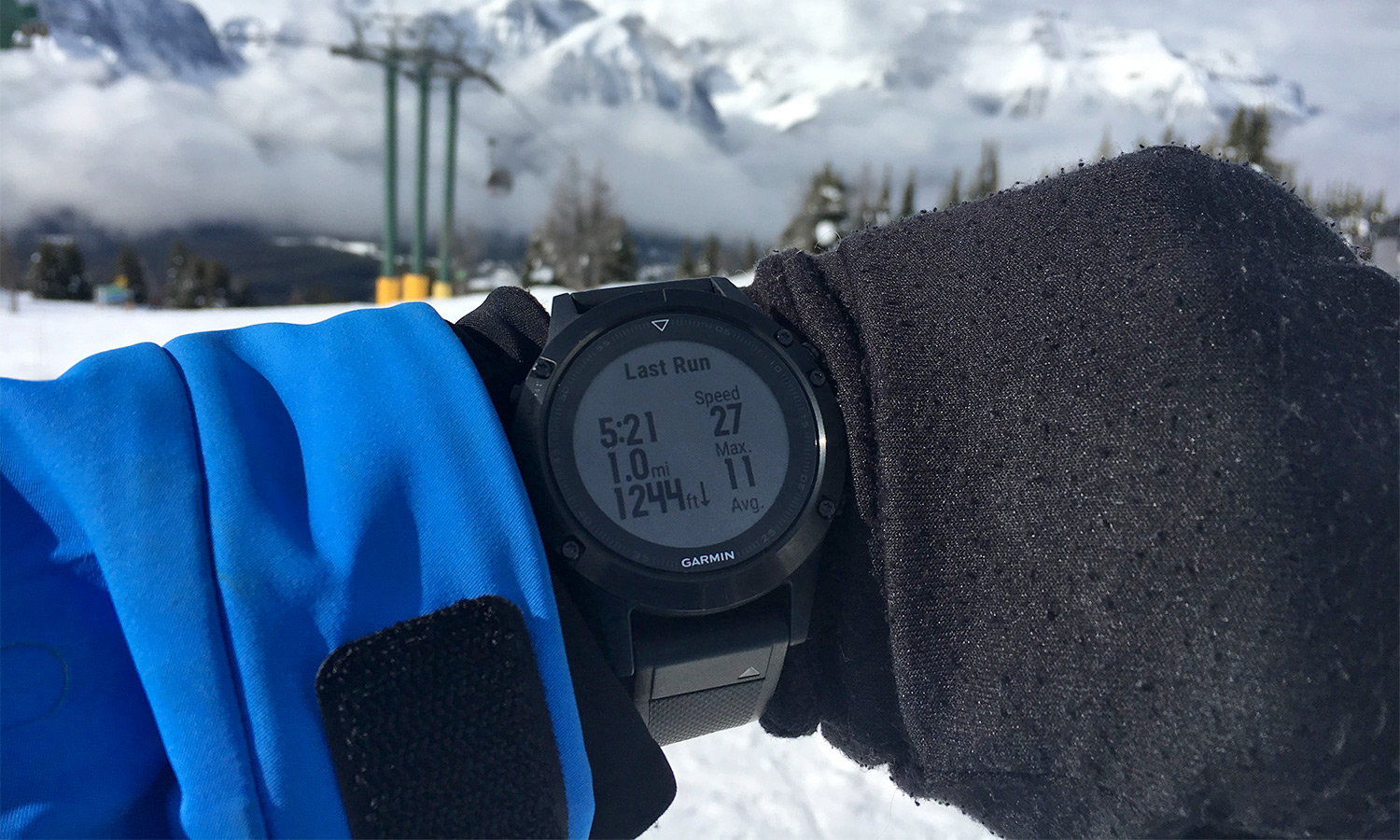
As with the running, my ski runs were viewable on the watch itself, as were details such as elevation loss and gain and the length, speed and time of individual runs. I could also see a map view of all my runs put together.
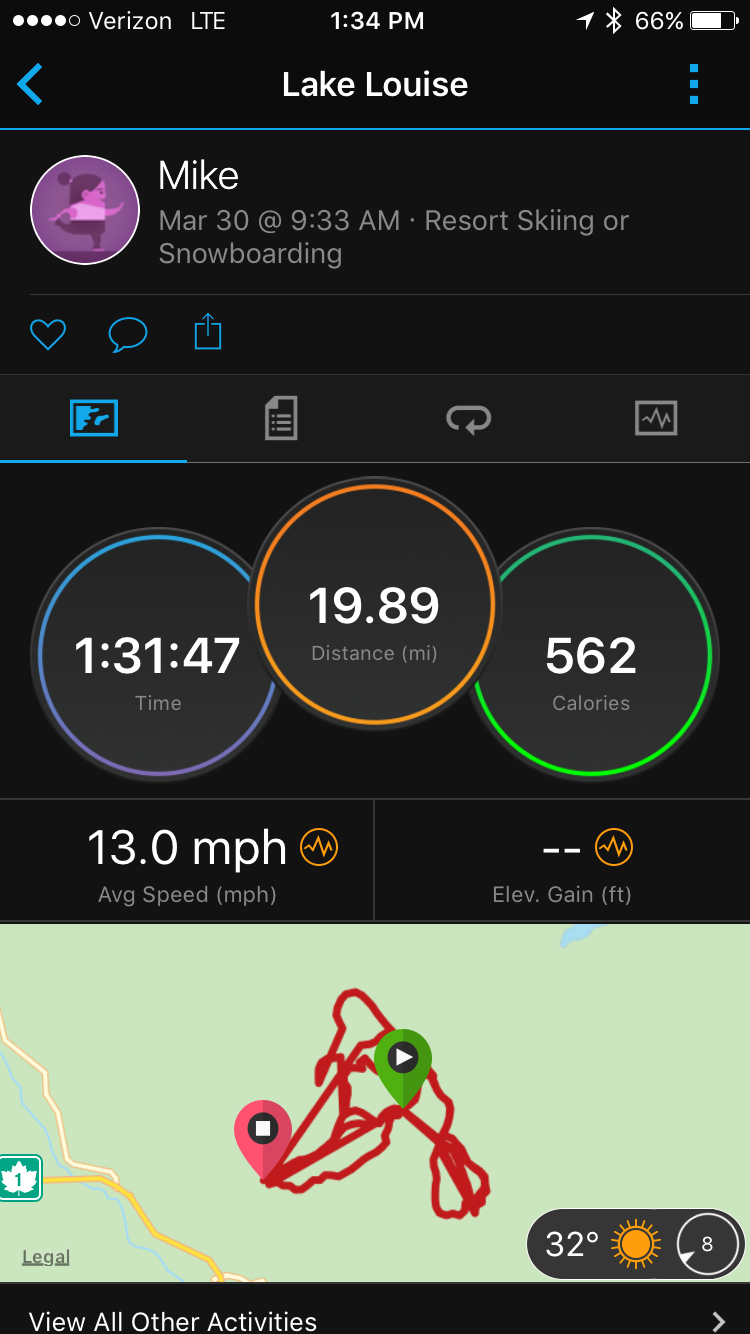
The only thing that didn't work well was the fenix 5's thermometer. Although the watch was strapped on the outside of my ski jacket, it recorded temperatures much warmer than the actual conditions.
App
It's been a few years since Garmin updated the look of its app, and I think it's time for a change. The app has a steeper learning curve than other fitness apps.
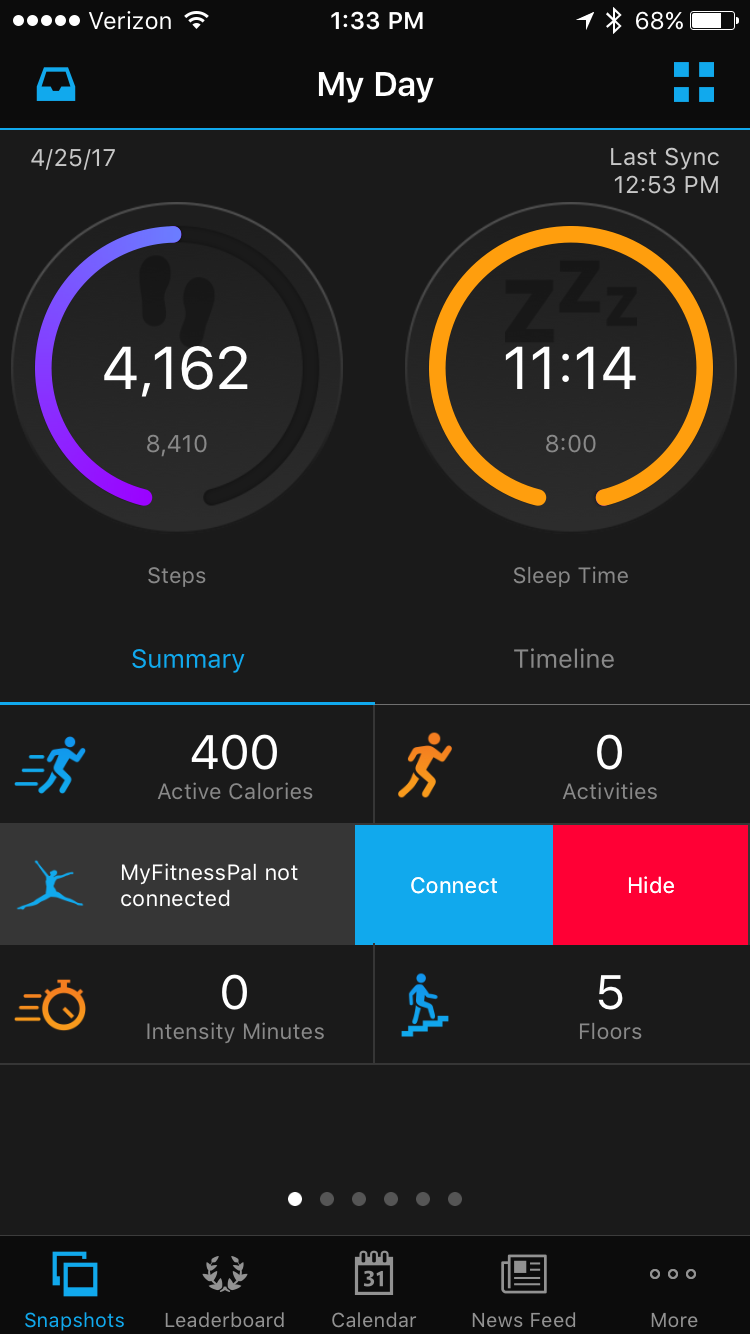
The home screen (also known as the Snapshot screen), which has a black background, has two large circles toward the top that show how many steps you've taken and how much sleep you've had. Below that are small blocks for Active Calories, Activities, MyFitnessPal, Intensity Minutes and Floors Climbed.
Swiping left or right shows you more information about various activities (steps, sleep, running, swimming, etc.). You can customize how many of these pages show up, as well as their order, by pressing an icon in the upper right corner of the screen. Too often, I pressed this icon trying to access settings for the fenix 5.
Along the bottom are icons for Snapshot, Leaderboard, Calendar, News Feed and More (where you can change device settings and the like).
Smartwatch-Like Features
While the fenix 5 isn't a smartwatch per se, Garmin's Connect IQ lets you swap out watch faces and install widgets that add some functionality to the watch.
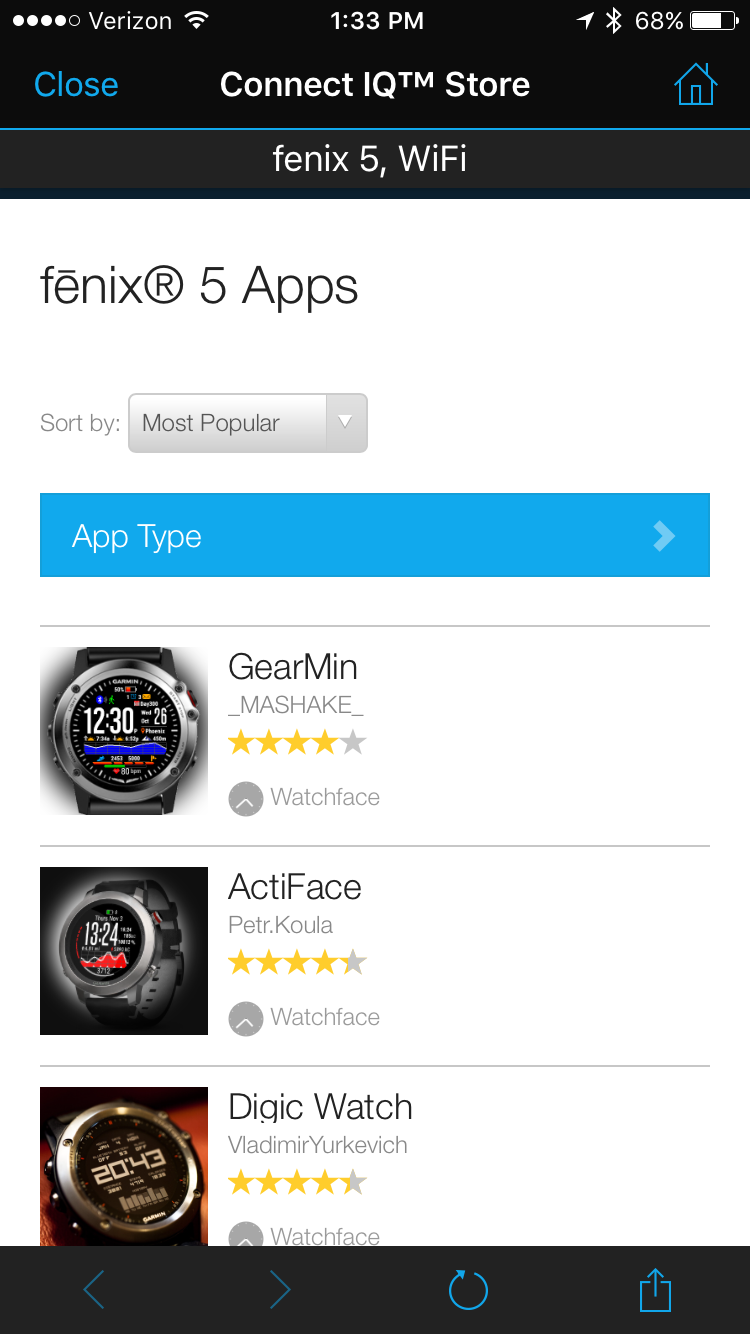
You can receive a localized weather forecast, a list of calendar appointments, and notifications, such as calls and texts. The fenix 5 only lets you view these, though, not respond to them.
One of the reasons I prefer wearing Garmin's watches over smartwatches is that I rarely have to worry about recharging.
However, you can control music playing on your smartphone. A recent update to the app also lets you connect the watch to Samsung's SmartThings smart home hub, so you can turn your lights on and off, for example, from the fenix 5.
About the only thing the fenix 5 doesn't have is onboard storage for music, like the TomTom Adventurer has. Still, TomTom's watch lacks the customizable faces, weather tracking and smartphone notifications that the fenix 5 offers.
Battery Life
One of the reasons I prefer wearing Garmin's watches over smartwatches is that I rarely have to worry about recharging. If you're not using GPS or the heart rate monitor, the fenix 5 will last up to two weeks. That means if you forget to bring the charger on a trip lasting more than a day, you won't have a useless hunk of metal on your wrist. If you are using GPS, the battery is rated to last up to 24 hours, which is more than twice what the TomTom Adventurer (11 hours) offers. If you turn on UltraTrac mode (where the watch pings the satellite only once every minute, rather than every second), the fenix 5 should last for up to 60 hours.
After I went for a 2-hour, 13.1-mile run using GPS and the heart rate monitor, the battery decreased by 9 percent. After I left GPS on for 2 hours while tracking my ski runs, the battery again dropped by 9 percent. I was able to ski first chair to last chair without worrying if the fenix 5 would run out of juice.
I also like that Garmin has continued to shrink the size of its charging cables. Rather than using a bulky wireless charger like so many smartwatches do, the fenix 5 has a small USB cable that snaps into a port on the back of the watch.
Fenix 5 versions
The $599 fenix 5S is the smallest and lightest of the three Garmin watches, at 1.7 inches in diameter and 2.4 ounces in weight. It also has a smaller, 1.1-inch display with a resolution of 218 x 218 pixels and the shortest battery life, at up to nine days in smartwatch mode and up to 14 hours in GPS mode.
Of the three watches, the fenix 5, which also starts at $599, has the longest battery life: up to two weeks in smartwatch mode (depending on settings) and up to 24 hours in GPS mode. Like the 5X, the fenix 5 has a 1.2-inch display with a resolution of 240 x 240 pixels.
The fenix 5X, which starts at $699, has 12GB of storage (the other two watches have a mere 64MB each), which is largely used for preloaded topographic and cycling maps, as well as more than 40,000 golf courses. The battery will last you up to 12 days in smartwatch mode (depending on settings) and up to 20 hours in GPS mode.
The sapphire edition of each watch — which features a more scratch-resistant sapphire face and a metal band — increases the price considerably. For instance, the sapphire fenix 5S and 5 cost $849 each.
Bottom Line
The Garmin fenix 5 is not a cheap GPS watch, but for outdoor adventurers who need or want to capture everything they do, this $599 device could be worth the investment. It provides detailed stats on a multitude of activities, has an accurate heart rate monitor, doesn't weigh your wrist down too much and lasts a long time on a charge.
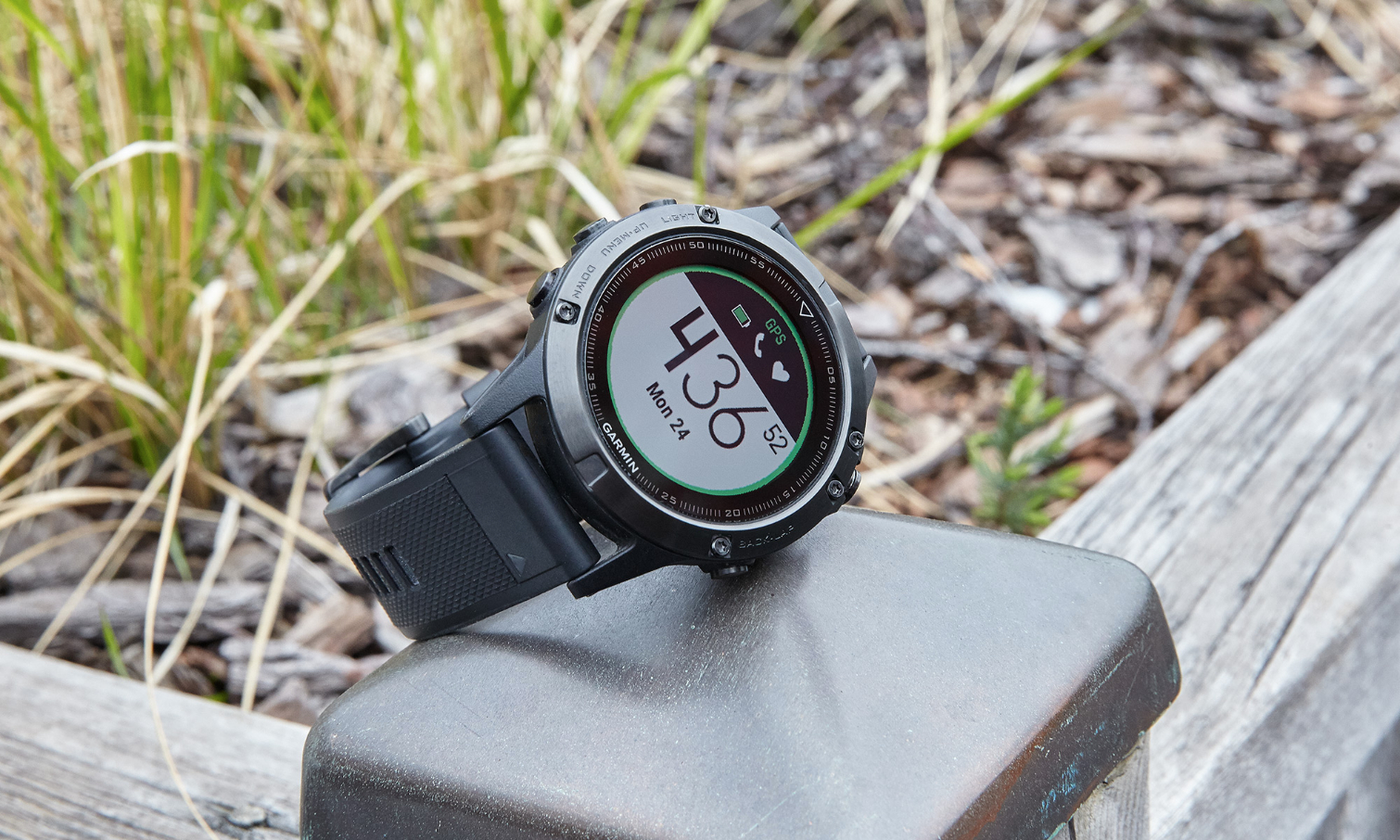
If your activities are more confined to running or biking, the much less expensive TomTom Spark Cardio 3 or Garmin Forerunner 235 would be better suited to your needs. However, if you spend every weekend in the woods, on a mountain or in the ocean, the fenix 5 could be just what you need.

Michael A. Prospero is the U.S. Editor-in-Chief for Tom’s Guide. He oversees all evergreen content and oversees the Homes, Smart Home, and Fitness/Wearables categories for the site. In his spare time, he also tests out the latest drones, electric scooters, and smart home gadgets, such as video doorbells. Before his tenure at Tom's Guide, he was the Reviews Editor for Laptop Magazine, a reporter at Fast Company, the Times of Trenton, and, many eons back, an intern at George magazine. He received his undergraduate degree from Boston College, where he worked on the campus newspaper The Heights, and then attended the Columbia University school of Journalism. When he’s not testing out the latest running watch, electric scooter, or skiing or training for a marathon, he’s probably using the latest sous vide machine, smoker, or pizza oven, to the delight — or chagrin — of his family.
